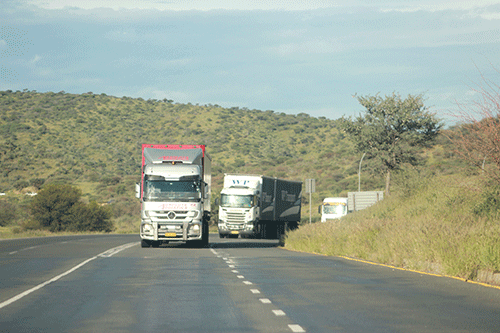The plan is in the pipeline but toll gates might not be coming soon. Cabinet has approved consultations into toll gates and the Road Fund Administration will return to seek implementation approval after these consultations.
However, it might take some time and getting approval is not automatic.
“A study was conducted and Cabinet has given approval for public consultations planned for the next six months. It is, therefore, not a foregone conclusion that implementation will take place,” RFA CEO Ali Ipinge told journalists in Windhoek yesterday.
Ipinge noted the administration’s funding gap has been growing over the years and revenue desperately needs to be sourced from somewhere.
He stated the administration currently collects only about N$2.4 billion per year from road users, while the funding gap stands at N$2.5 billion.
He said the number of vehicles on the roads increased massively in recent years, hence the need for tolls as a revenue alternative.
Ipinge said value addition and job creation to road users will far outweigh the cost of living on badly maintained roads.
“Indirectly, well-maintained roads contribute to economic growth and job creation,” he said.
He explained the study informed that tolling could be sustainably introduced on Namibia’s road network.
The system proposes introducing tolls along 23 roads in Namibia.
The CEO added, it is common knowledge that road users’ charges (RUCs) revenue is threatened by the much-needed technological advancements from car manufacturers aimed at curbing carbon emissions and reversing global warming, equally, Ipinge said RFA is challenged to find solutions to the oncoming threat of the diminishing revenue.
He added, as part of assessing how to augment diminishing revenue from the fuel levy, management had to interrogate alternative ideas including tolling.
The RFA fuel levy currently stands at N$1.48 per litre.
Ipinge noted the fuel levy per litre of petrol and diesel grew over the years with only 68 cents in 2000 to 148 cents in 2022.
Thus, RFA fuel levies grew by 80 cents over the last 22 years, which he said is very low compared to regional road funds levies.
“Road transport carries 90% of economic goods in Namibia, therefore, allowing our road network to fail, will fail the whole economy. The major economic benefit for road users will be savings in vehicle operating costs due to good pavement surfaces,” he pointed out.
Since its adoption, RFA has invested more than N$30 billion in road infrastructure. He said due to recurrent under funding over the 15 years, the condition and quality of the road network continues to deteriorate.
To restore gravel roads and those leading to tourist destinations, an investment of at least N$675 million per year is required for the next five years.
“Namibia continues to enjoy good rankings in the road and transport sector. It is first in Africa in terms of quality and access, fifth globally and in terms of roads per capita, it is 23rd globally. This is not by chance but through combination of better planning, road designs, road maintenance strategy, asset management systems and ring-fenced RUCS,” said Ipinge
At the same occasion, Roads Authority CEO Conrad Lutombi supported the idea of toll roads, saying it will help raise much needed revenue to keep the roads network at standard.
“This will help accessibility to remote areas. As Namibia is expected to become a logistics hub in the next five years, we are expecting an influx of heavy trucks thus the need to keep roads in good quality,” he noted.
The RFA currently receives its revenue through the RUCs, which were developed with the aim of economically recovering the full cost of road expenditure from road users in an equitable manner.
The RUCs were designed to ensure revenue needed to provide and maintain roads is raised from road users (including foreign road users) rather than the general taxpayer. The RUCs were also designed to price the use of roads to improve economic efficiency in road transport by removing price distortions and charging road users according to the actual roads’ utilisation.
Looking into the future, Ipinge said, the RFA faces numerous challenges but said for road users, an emerging opportunity is the advent of fuel-efficient cars and electric vehicles. This transport optimisation means the RFA will be generating less revenue in the future from fuel levies, thereby further reducing the ability to maintain national roads.
The announcement earlier this week came as a shock to many as the community is already challenged with the escalating cost of living and other economic challenges.
Opposition parties swiftly rejected the idea.
In a statement on Wednesday, the official opposition, Popular Democratic Movement (PDM), said the introduction of toll gates will only burden transport users.
“It is dumbfounding that while there is a strong push by South Africa for the scrapping of e-tolls, which will this year cost the South African government R23.7 billion to settle the debt of the South African National Road Agency emanating from e-tolls, the Namibian government nevertheless want to implement the same catastrophic system at the expense of road users,” reads the statement.
PDM further urged Cabinet to abort the introduction of toll gates in Namibia. It requested government to rather find viable solutions to fund and maintain road infrastructure.
“Under the prevailing economic circumstances, the proposed N$3.4 billion total cost of the project before operation – to cover the RFA N$1.8 billion shortfall – will not lead to the much-needed economic stimulation and human capital development,” the Landless People’s Movement (LPM) also said this week.
“The total net cost to the Namibian economy due to the Cabinet approved and now accumulated foreign debts, requires sustainable fresh ideas and informed minds to ensure that greater opportunities for prosperity and growth are realised.”
The LPM urged Namibians to not accept tollgates.
mndjavera@nepc.com.na
Caption


